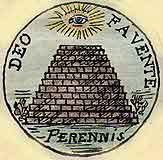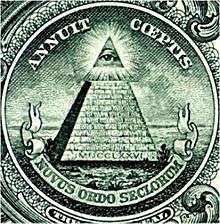Annuit cœptis
Annuit cœptis (/ˈænuɪt ˈsɛptɪs/, Classical Latin: [ˈannʊ.ɪt ˈkoe̯ptiːs]) is one of two mottos on the reverse side of the Great Seal of the United States. (The second motto is Novus ordo seclorum; another motto appears on the obverse (front) side of the Great Seal: E pluribus unum.)[1] Taken from the Latin words annuo (third-person singular present or perfect annuit), "to nod" or "to approve", and coeptum (plural coepta), "commencement, undertaking", it is translated, "Providence favors our undertakings" or "Providence has favored our undertakings" (annuit could be in either the present or perfect tense).[2]
.svg.png)
On the Great Seal
In 1782, Samuel Adams appointed a design artist, William Barton of Philadelphia, to bring a proposal for the national seal.[3] For the reverse, Barton suggested a thirteen-layered pyramid underneath the Eye of Providence. The mottos which Barton chose to accompany the design were Deo Favente ("with God's favor", or more literally, "with God favoring") and Perennis ("Everlasting"). The pyramid and Perennis motto had come from a $50 Continental currency bill designed by Francis Hopkinson.[4][lower-alpha 1]

Barton explained that the motto alluded to the Eye of Providence: "Deo favente which alludes to the Eye in the Arms, meant for the Eye of Providence."[5] In western art, God is traditionally represented by the Eye of Providence, which principally symbolizes God's omniscience.
When designing the final version of the Great Seal, Charles Thomson (a former Latin teacher) kept the pyramid and eye for the reverse side but replaced the two mottos, using Annuit Cœptis instead of Deo Favente (and Novus Ordo Seclorum instead of Perennis). When he provided his official explanation of the meaning of this motto, he wrote:
The Eye over [the pyramid] and the motto Annuit Cœptis allude to the many signal interpositions of providence in favor of the American cause.[6]
Change from Deo Favente to Annuit Cœptis

Annuit Cœptis is translated by the U.S. State Department,[7] the U.S. Mint,[8] and the U.S. Treasury[9] as, "He [God] has favored our undertakings" (brackets in original). However, the original Latin does not explicitly state who (or what) is the subject of the sentence.[10] Robert Hieronimus, a scholar of American iconography, has argued that Thomson's intent was to find a phrase that contained exactly 13 letters to fit the theme of the seal.[11] On the obverse was E Pluribus Unum (13 letters), along with 13 stars, 13 horizontal stripes (on the shield on back of the US$1 dollar bill), 13 vertical stripes, 13 arrows, 13 olive leaves, and 13 olives. The pyramid under the motto, Annuit Cœptis, has 13 layers. According to Hieronimus, Annuit Cœptis has 13 letters and was selected to fit the theme. Deo Favente had only ten letters. However, Annuit cœptis is written with a ligature on the seal, forming actually only 12 characters.
Classical source of the motto
According to Richard S. Patterson and Richardson Dougall, Annuit cœptis (meaning "favours our undertakings") and the other motto on the reverse of the Great Seal, Novus ordo seclorum (meaning "new order of the ages"), can both be traced to lines by the Roman poet Virgil. Annuit cœptis comes from the Aeneid, book IX, line 625, which reads, Iuppiter omnipotens, audacibus adnue coeptis.[12] It is a prayer by Ascanius, the son of the hero of the story, Aeneas, which translates to, "Jupiter Almighty, favour [my] bold undertakings", just before slaying an enemy warrior, Numanus.
The same language also occurred in an earlier poem of Virgil, the Georgics. In line I.40 of that work is the phrase "da facilem cursum atque audacibus annue cœptis". The line is addressed to Caesar Augustus and translates to "give [us] an easy path and nod at our audacious undertakings."
Notes
- The note can be seen here, and the pyramid portion here.
References
- "E Pluribus Unum - Origin and Meaning of the Motto Carried by the American Eagle". greatseal.com.
- "Annuit Coeptis - Origin and Meaning of the Motto Above the Pyramid & Eye". greatseal.com.
- MacArthur, John D. (2011). "Third Committee". Retrieved 11-25-2011.
- "Third Committee's Design for the Great Seal - 1782". greatseal.com.
- Papers of the Continental Congress, item 23, folios 137-139.
- Journals of the Continental Congress, June 1782
- "The Great Seal of the United States" (PDF). U.S. Department of State, Bureau of Public Affairs. 2003. Retrieved November 25, 2011.
- Bureau of Engraving, Currency Notes
- U.S. Treasury (2010). "Portraits & Designs". Retrieved 11-25-2011.
- In The Oxford Handbook of Church and State in the United States. New York: Oxford University Press, 2010]
- Hieronimus, Robert (2005). Founding Fathers, Secret Societies: Freemasons, Illuminati, Rosicrucians, and the Decoding of the Great Seal. Inner Traditions / Bear & Co. pp. 111–. ISBN 978-1-59477-865-0.
- Vergilius Maro, Publius (29–19 BC). Aeneid. Retrieved 11-25-2011.
Further reading
- Patterson, Richard Sharpe; Dougall, Richardson (1978) [1976 i.e. 1978]. The Eagle and the Shield: A History of the Great Seal of the United States. Department and Foreign Service series ; 161 Department of State publication ; 8900. Washington : Office of the Historian, Bureau of Public Affairs, Dept. of State : for sale by the Supt. of Docs., U.S. Govt. Print. Off. LCCN 78602518. OCLC 4268298.
External links
